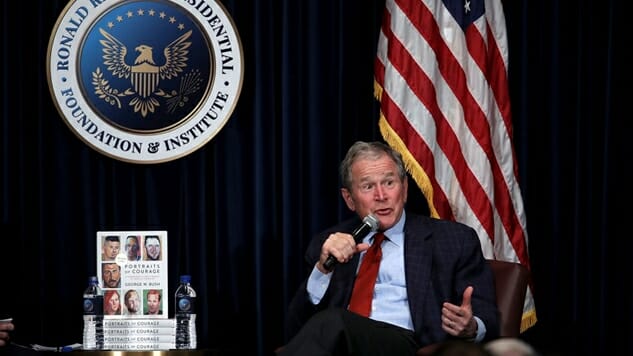The Media’s Rehabilitation of George W. Bush
The Press' Complicity in Rehabilitating George Bush's Image Normalizes an Era of War and Torture
Photo by Justin Sullivan/Getty
Leaving office after eight disastrous years, George W. Bush wisely disappeared. It was now former President Obama’s mess to clean. The financial markets had crumpled; millions of Americans were out of work. Families were losing their homes. The American auto industry teetered on the brink of collapse. Across the globe, U.S. troops were embroiled in the quagmires of Iraq and Afghanistan, while Americans at home were subject to post-9/11 warrantless surveillance programs. The national memories of Hurricane Katrina were beginning to fade, but in New Orleans, the wounds were still fresh.
But all would appear to be forgiven, judging by the ecstatic reaction to Bush’s five-word analysis of current President Donald Trump’s inauguration address: “That was some weird shit.” If the American people and the click-hungry press want their “W” back—the Texan, the charmer, the straight shooter, the harmless Mispronunciator in Chief—they can keep him. If comparing Bush to Trump is what it takes to spur a renaissance of opinion, how standards have fallen.
Rewind to the years of Obama’s double term. There was little sight of Bush, as Obama labored to reaffirm the economy and other wreckage left by the previous administration. That was until hacked Bush family emails revealed his new fondness for painting, of all things. It was the first time many newsreaders had heard from Bush in a half decade. The emails revealed amateurish, partially-nude self-portraits in a bathtub (Bush said, in typically rakish character, that he chose his subject matter to shock his painting instructor). This was a departure from how most presidents spend their years following office: stumping for their party’s new leadership, founding charities, building a legacy. It suggested a man in exile, if the mind is given to a sympathetic reading. Or, alternately, a man in oblivion, playing with his toys as the world burns.
Now “W” has reemerged, cannily positing himself as the sincere voice during an administration that can only make him look competent in comparison.
The first glimpse of the new Bush came during Trump’s campaign. “I’m worried that I will be the last Republican president,” Bush said in June, suddenly wary of his party’s direction, if not the country’s. It revealed a presidential responsibility that was notably absent during eight years of Birther nonsense, a decade-plus of endless Mideast war, a crawling recovery from the recession, a legacy of torture, warrantless surveillance, and unchecked homeland security apparatuses. Nevertheless, by November, the Bush Rehabilitation was in full swing, with the family spokesperson confirming that neither he nor the former first lady had voted for Trump. The game continues. On inauguration day, George W. Bush battled his poncho, lost, and became a meme. This is Bush re-imagined as the folksy, harmless grandpa, cute as a button, caught in the rain, and Twitter loved it.
NPR gladly repackaged the tweets into a story, highlighting: “Never thought I’d say that George W Bush is all of us, but here we are;” and “The George W. Bush reaction cam during Trump’s inauguration speech was lit.” What fun might be had watching the former leader of the free world struggle with a sheet of plastic is tempered by the fact that, on the same day, U.S. airstrikes in Syria killed 100 supposed Al Qaeda fighters. Or, the day before, two United States Air Force bombers attacked Islamic State training camps in Libya overnight, killing more than 80 militants as the endless war to contain the threat of ISIL, born of the U.S. invasion of Iraq, continues to spill across the entire region.
Or, more directly, do the residents of Mosul, Iraq find the former president cute, as well?